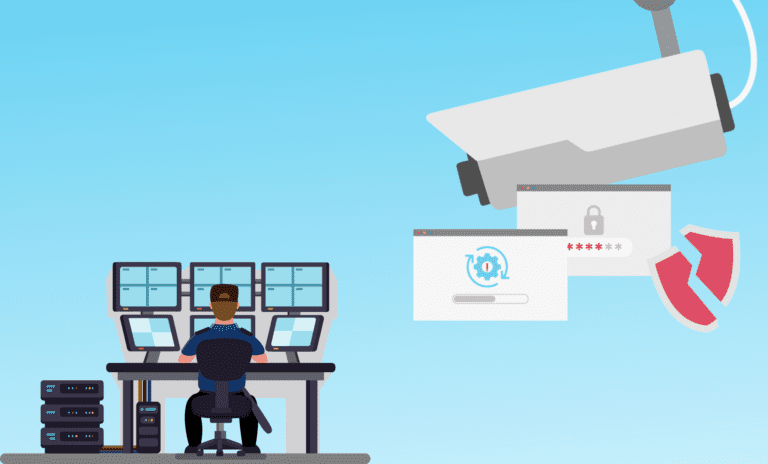
As countless organizations struggle to manage their physical security devices, their difficulties are often compounded by a significant information gap between their physical security and IT teams.
With the two teams struggling to share information and work together effectively, that gap can create expensive inefficiencies. More importantly, it can increase the chances of devices having prolonged and undetected downtime – leaving them inadequately hardened and maintained and, therefore, vulnerable to hackers and cybercriminals.
If your organization is struggling with this challenge, it’s worth considering how a major North American logistics company successfully bridged that gap and gained control of its physical security device management. Working with SecuriThings, this company has significantly improved its security posture through automation and enhanced visibility, helping it stay safe from both physical and cyber threats.
Here is a look at the customer’s success story, which sheds light on what all types of organizations can learn from this company to improve their own security.
The challenge: Juggling a large, highly diverse fleet of devices and systems
This logistics company’s challenge of managing its physical security devices stems from its size and the complexity of its physical security ecosystem. It has 194 sites throughout North America, where it has deployed more than 2,500 physical security devices. These devices were produced by 11 different manufacturers and rely on 29 different management systems.
As the company struggled with an overwhelming physical security ecosystem, its ability to manage its physical security devices was hampered because critical device-related information was not reaching the people who needed it when they needed it.
This left the company exposed to both physical and cyber risks, as well as the danger of legal liability in case anything went wrong as a result of inadequate device management. It was also inefficient, expensive, and frustrating – making cooperation and collaboration between the company’s physical security and IT teams especially difficult.
To streamline the management of its physical security devices, the logistics company started working with SecuriThings, gaining powerful automated capabilities and comprehensive visibility into the real-time status of its physical security devices and other network assets.
Bridging the IT-physical security information gap with SecuriThings
Working with SecuriThings has allowed the logistics company to address both physical and cyber risks more effectively while making sure that critical information about its physical security devices reaches the right employees at the right time.
One reason the insight provided by SecuriThings is so helpful is the way it sheds light on downtime and other technical issues that can sometimes arise. Not only does SecuriThings rapidly alert the company when these issues occur, but it automatically determines whether the source of a problem is within a physical security device or management system – or due to an IT asset (such as a network switch or router). In addition to assisting with root cause analysis, this approach makes it clear whether a given issue should be addressed by the company’s IT or physical security team – helping both teams to address technical issues efficiently.
The company’s approach to bridging the information gap between IT and physical security also helps it protect its physical security devices from hackers and cybercriminals. With SecuriThings automatically performing processes such as password rotations and firmware upgrades, the physical security team can easily ensure that its devices are compliant with IT standards for device hardening and maintenance. And because SecuriThings automatically notifies the company when it detects indications that a device is at risk of being targeted, the company’s physical security and IT teams have an extra layer of defense against cyber threats – further helping them avoid a risky information gap.
Taken together, the company’s results have improved its overall security posture and helped it steer clear of the risks of noncompliance and legal liability that can result from inadequately managed physical security devices. Not only has the company saved money by streamlining the management of its physical security devices, but it has avoided two key dangers: that a physical security incident could occur while devices are down and that a cyberattack could take advantage of vulnerabilities within one or more physical security devices.
Conclusion: Bringing physical security and IT together
As organizations struggle to manage their physical security devices properly, they often suffer from a lack of comprehensive, real-time visibility, which contributes to a serious information gap between physical security and IT teams. This can result in mutual frustration and finger-pointing, making it even more difficult for the two teams to work together successfully.
This type of information gap is a serious risk, but it’s far from insurmountable.
This North American logistics company’s success story illustrates the benefits that physical security and IT teams can enjoy when they combine automation and enhanced visibility with cooperation, collaboration, and information sharing. By using this type of approach to bridge the gap between physical security and IT teams, organizations of all types can significantly improve their security posture – helping them stay safe from both physical and cyber threats.
For a closer look at how to bridge the gap between physical security and IT teams, watch the on-demand video of a recent webinar on this very topic that we ran together with our partners at Salient.




